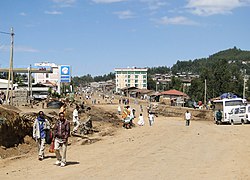world.wikisort.org - Ethiopia
Debarq (Amharic: ደባርቅ) also spelled Dabareq and Debark, is a town in northern Ethiopia, 90 kilometers north-east of Gondar on the highway between Gondar and Axum, and is in the Semien Gondar Zone of the Amhara Region. It has a latitude and longitude of 13°08′N 37°54′E and an elevation of 2850 meters above sea level.[2][3]
Debarq
ደባርቅ | |
|---|---|
 Main street of Debark | |
 Debarq Location in Ethiopia | |
| Coordinates: 13°08′N 37°54′E | |
| Country | |
| Region | Amhara |
| Zone | North Gondar |
| Elevation | 2,850 m (9,350 ft) |
| Population (2022) | |
| • Total | 59,920 [1] |
| Time zone | UTC+3 (EAT) |
Debarq is located on the western foothills of the Semien mountains, and nowadays serves as a starting point for hiking tours to the Semien Mountains National Park.[3]
History

17th century
The earliest sourced mention of Debarq appears to date back to the late 17th century, serving as a stopover for replenishment to journeys and military campaigns that emperor Iyasu the Great undertook from Gondar to the north.[3]
18th century
In early 1770, explorer James Bruce was one of the earliest foreign sources to mention Debarq. Bruce noted in his journal, the contrasting and temperate climate as he passed through a market in Debarq.[note 1]
Icy winds compete with the blazing sunshine and people with eyes asquint, ruined by sunlight at high altitude, walk for miles to barter on the eroding mountainside." The country about was riddled with hermits and exiles pretending to be hermits, who lived in caves outside the bounds of normal society. The road grew progressively worse as they made their way up the mountain
— James Bruce, [4]
19th century
In 1814, Debarq appeared on a map by traveller Henry Salt[note 2][4]
Debarq's prosperity was due to its location on the Gondar-Massawa trade route; it is one of the stations on a route of the 1840s, according to a list compiled by Antoine Thomson d'Abbadie in his Geodesie d'Ethiopie.[5] Richard Pankhurst notes that by the early 19th century its market was important enough to be one of six in Ethiopia requiring a nagadras ("head of the market") to oversee it and collect the fees.[6] The revenue from taxes levied on the marketplace in the 1830s paid the governor of Semien province (Wube Haile Maryam) 3,000 Maria Theresa Thalers and about as much to the nagadras.[7]
During a clash with his rebellious nephews, Emperor Tewodros saw his close friend and advisor John Bell killed in battle here in 1860. Although his nephews were killed in the skirmish, and their 1700 followers immediately surrendered, he exacted vengeance the next day by beheading all of their men.[8]
20th century
During Ethiopia's occupation by Facist Italy, Debarq was the scene of violent fighting between the fascist occupiers and local freedom fighters. After the liberation Debarq became the capital of the Semien Awragga.[3]
The Tigrayan People's Liberation Front launched an offensive against the 603rd Army Corp of the Derg, and after destroying the government forces stationed at Debarq, they controlled the town 3 January 1989.[8]
Demographics
Based on figures from the Central Statistical Agency, in 2005 Debarq had an estimated total population of 24,997, of whom 11,850 were males and 13,147 were females.[9] The 1994 census reported this town had a total population of 14,474 of whom 6,235 were males and 8,239 were females. It is the largest settlement in Debarq woreda.
Debarq was reported to have a population of about 8500 in 1984.[4]
Notes
- James Bruce spelled Debarq as Dobarke [4]
- On Henry Salt map, Debarq was spelled as Davarik[4]
References
- World Population Review https://worldpopulationreview.com/countries/cities/ethiopia
- Ethiopian Roads Authority, Gondar-Debark Road Project: Review of Environmental Impact Assessment, February 2007, p. 13. The geographical coordinates and elevation for Debarq are disputed: four other possible values are listed at "Local History in Ethiopia"[permanent dead link] (pdf), The Nordic Africa Institute website
- Uhlig, Siegbert; Bausi, Alessandro; Yimam, Baye, eds. (2003). Encyclopaedia Aethiopica: D-Ha. Wiesbaden: Harrassowitz. pp. 3–4. ISBN 9783447052382.
- "Debark" (PDF). The Nordic Africa Institute. The Nordic Africa Institute. 2005. Retrieved 2022-09-03.
- G.W.B. Huntingford, Historical Geography of Ethiopia from the first century AD to 1704 (London: British Academy, 1989), p. 255.
- Richard Pankhurst, Economic History of Ethiopia (Addis Ababa: Haile Selassie University, 1968), p. 520
- Samuel Gobat, Journal of Three years' Residence in Abyssinia, 1851 (New York: Negro Universities Press, 1969), p. 149
- "Local History in Ethiopia," The Nordic Africa Institute website
- CSA 2005 National Statistics, Table B.4 Archived November 23, 2006, at the Wayback Machine
На других языках
- [en] Debarq
[ru] Дебарк
Дебарк (амх. ደባርቅ) — город, расположенный на севере Эфиопии в 90 км (56 миль) к северу от Гондэра.Другой контент может иметь иную лицензию. Перед использованием материалов сайта WikiSort.org внимательно изучите правила лицензирования конкретных элементов наполнения сайта.
WikiSort.org - проект по пересортировке и дополнению контента Википедии